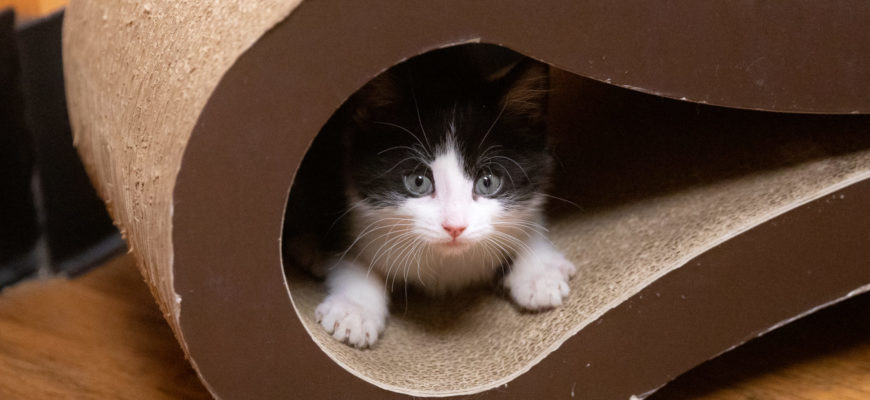Congratulations on adopting your new kitten!! Here are some tips to help you in the coming days with your new friend!
Please remember: your new kitten could be frightened and confused, even if they were happy and outgoing when you met them at the shelter. Cats like routine and to have control over their environment, so it may take them a few days to feel the safety and comfort that they felt in the den they had created for themselves at the shelter or in their foster home. Kittens tend to settle into a new environment pretty quickly, but following these suggestions should help you through that acclimation period. It’s also important to establish good litterbox habits, and with kittens, they really need this smaller space initially to understand where there food, water and litterbox resources are… don’t worry, you’ll be able to move that litterbox with time, but having this home base will be important for your kitten initially.
We suggest that you set up a kitten safe bedroom or bathroom for your new friend and give them a smaller space to acclimate to before they are given full access to your home. This should be a quiet spot, where there isn’t a lot of traffic and you can close the door to be sure they’re safe inside their room. Make sure that they have access to the following things in their new room:
- Fresh water, dry food and some wet food.
- A large, low sided litterbox. Make sure you offer a litter box in a prominent and easy to find spot, using the type of litter that was used at the shelter. If you plan to switch litter, you’ll want to do so slowly, in increments, so that your adopted kitten can get used to the texture of the new litter.
- A variety of beds, blankets and cozy hiding spots.
- A variety of toys. Kittens generally love to play, this is a great chance to learn what kind of toys he likes best!
- A vertical space for them to climb on. Investing in a cat tree is a wonderful idea as they can be moved around the house as you give your kitten more access to the home, and many kittens need the vertical space to help them burn off playful energy.
While your kitten is in her new room, make sure to give her a lot of contact!!
- Lots of playtime built into the day, using a variety of toys.
- Gentle pets around face and cheeks, moving slowly down her back. Make sure she remains calm for this type of petting. If she becomes overstimulated, redirect in any game that interests her. More on that later!
- Use wet food to build trust and as a positive reinforcer for good behavior. We’ll talk a little more about that later, as well!
- Gently handle his paws and pick him up gently. If he struggles at all or seems uncomfortable, stop this interaction and make it fun again by engaging in play or offering treats. You can build up tolerance for handling by taking it slow and in steps, rewarding at every step, until he’s comfortable letting you pick him up and trim his nails.
- Make sure to introduce him to the other humans in the house!!! If he’s confident and asking for attention, introduce him to his new family slowly and with care, asking all of the people who meet him to handle him in the same ways mentioned above.
Time to leave the safe room!
- You’ll know it’s time because your kitten is confident in his space. He comes out to you when called and doesn’t startle at noises and new people. You can keep his safe room for him in case he becomes overwhelmed in the home, or for use when you’re not home or are in bed.
- If there are other animals in the home, please see our handouts on introducing cats to other cats or to dogs, available on our website. This introduction process should take place before you give your kitten access to your home.
- Slowly give your kitten access to the home, making sure that there are plenty of litterboxes throughout the home. Remember, kittens have tiny bladders, it can be hard to find a litterbox when you’re tiny and the bathroom is really far away! Once he’s a little bigger, you can move the boxes to places that are a little more comfortable for you and for him.
- Once your kitten is consistently using his litterboxes and seems comfortable and confident in his new home, it’s ok to dismantle the safe room and leave him out while you’re not home.
- Make sure that you have plenty of litterboxes, vertical spaces and cat trees, resting spots, feeding stations and toys available to your kitten in their new home!
A word on play:
- If your kitten is in play mode, it’s best not to pet him. If he approaches you in play, offer just that, playtime. Using wand toys, by tossing rolling toys, offering battery operated toys, you can teach your kitten that playtime happens with these tools, not by biting human hands or feet. Use food as a reinforcer during these times, as well, if needed. Offer a great play session and then a meal of wet food, this will give them a great cycle of hunt, catch and then eat, which is a natural progression of behavior for a cat. Any time your kitten becomes overstimulated, nipping or batting at you, redirect into play.
- If your kitten approaches in a calm manner, maybe purring or with a soft, calm body, pet him. You can use food to reinforce this behavior, telling them that this kind of attention seeking is appropriate. Keep a close eye on body language and redirect into play before nipping happens.
- Swap out toys regularly. Cats become bored easily, swapping out toys on a regular basis keeps them new and exciting for your kitten.








